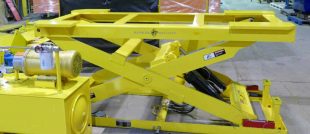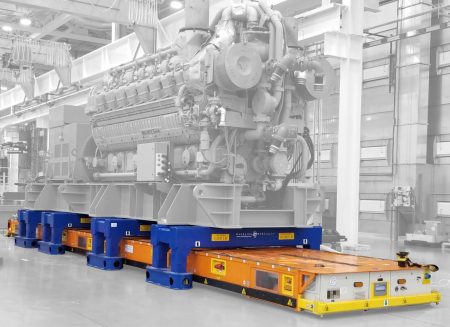
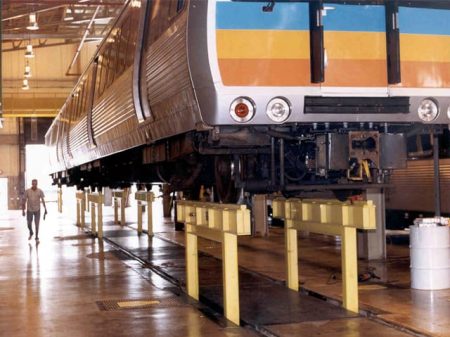
Scissor Lift Safety and Fall Protection

Scissor Lift Safety and Fall Protection
A Scissor lift is a type of aerial lift that provides a stable work platform designed for accessing high elevation areas with a minimum fall risk to the personnel working from the scissor lift. The scissor lifts safety is superior to using ladders or scaffolds; the scissor lift fall protection offers a safer working platform. Provincial and federal bodies mandate scissor lift safety procedures; however, scissor lift accidents can still occur.
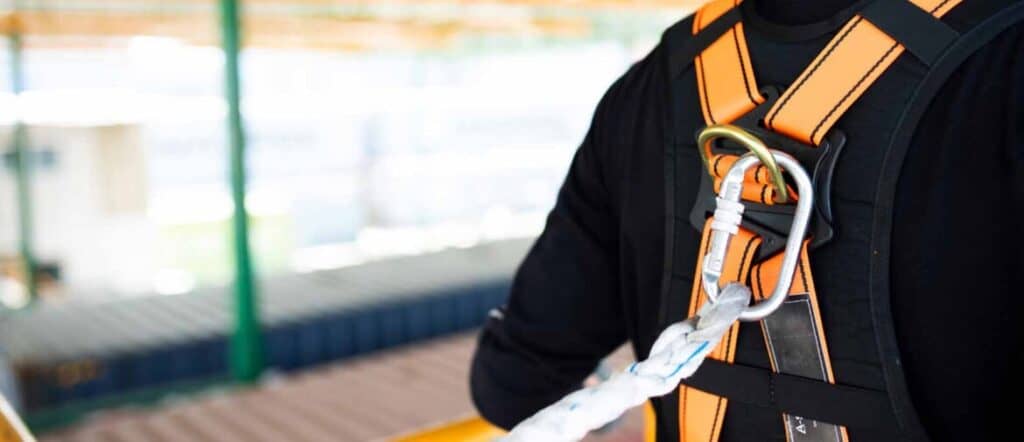
Companies must invest in training for workers to outline all scissor lift safety procedures, offer scissor lift safety tips, and invest in scissor lift fall protection for its operators.
The Center for Construction Research and Training (CPWR) reports that an average of 26 per year results from aerial lift accidents representing 2 to 3% of all construction deaths. Fatalities from scissor lift accidents were mainly caused by falls, collapses, tip-overs and electrocutions.
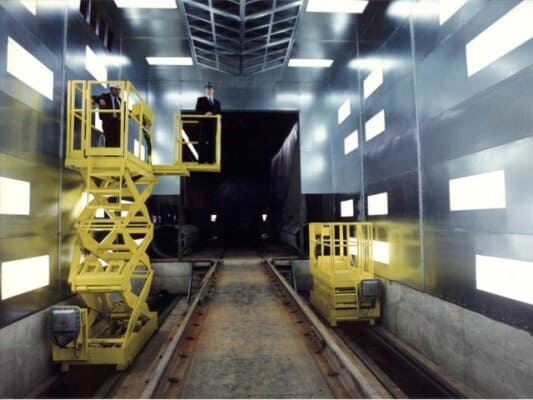
Modern Scissor lifts have interlocking safety mechanisms built into them. However, it is still possible for human operators to override tight-knit safety controls. Eliminating the possibility of human error is why regular training and certification is critical to refresh this safety knowledge among employees and third-party contractors.
Below are some recommended scissor lift safety tips to enforce in your company’s scissor lift safety procedures:
- Inspect the scissor lift before turning it on and operating. If the scissor lift fails this inspection, report the problem to the supervisor or person in charge and take it out of service until the problem is addressed. Never try to fix the issue on your own.
- Inspect the work environment surrounding the lift’s location. Check for unsecured cabling, uneven surfaces, obstructions, and objects that could interfere with the scissor lift’s operations. Watch out for obstacles when operating the scissor lift or moving the equipment.
- Section off the scissor lift’s operating area. Install cones around the lift and do not allow anyone to stand, walk or work too close or under the raised platform.
- Never exceed the lift’s maximum load lifting capacity as indicated by the manufacturer.
- Always read any scissor lift warning labels and ensure you are operating the scissor lift in accordance with its manufacturer’s specifications.
- Unless approved by the scissor lift manufacturers, do not load and carry materials on the enclosure’s railings. If your work involves taking materials into the working platform, ensure the scissor lift states the maximum weight it can handle.
- Always consider the combined weight of people and equipment operating on the scissor lift each time before using the equipment and ensure the total weight does not exceed what the manufacturers state as the maximum load.
- Conduct regular maintenance in line with the manufacturer’s guidelines for your scissor lift to identify potential issues and fix them before the scissor lift fails. Regular maintenance reduces chances of mechanical failure, equipment downtime, and fatal injuries. A good maintenance program includes:
- Testing all electrical and mechanical components in the scissor lift
- Checking if the guardrail and fall control systems are in good condition
- Inspecting the brakes to ensure they can hold the lift in position
- Testing the safety interlocks to ensure they cannot be easily overridden
In addition to the safety tips above, The Canadian government outlined comprehensive safety measures in the Occupational Health and Safety Act to protect employees and companies from injuries, deaths, and litigation. The best practice is to engage the services of legal personnel to help you develop safety standards in line with government regulations and industry practices.
Always review your company’s safety measures and policies to ensure they’re up to date and within the legal jurisdiction of your region. The Occupational Health & Safety Act (OHSA) requires companies to review their safety policies annually and safety programs at least every three years.
The OHSA requires employers to place fall-protection systems for structures requiring workers to operate from 3m above ground. So which fall protection ensures maximum safety?
Guardrails are stationary systems used to secure workers from falling when working on a scissor lift. The Canadian Centre for Occupational Health and Safety(CCOHS) recommends guardrails for scissor lift fall protection because they’re visible and do not require extensive training on using them.
On the other hand, fall arrest/protection systems are components designed to restrain operators from falling or in case of a fall and are used where there’s a risk of free fall from an elevated position.
A guardrail is a sub-category under fall arrest systems and is the first consideration when implementing fall arrest systems in your scissor lift safety procedures. There are two types of guardrails – manufactured guardrails and job build guardrail systems.
Manufactured guardrails have parts made from various materials such as metal, mesh, or netting, while job build guardrails are mainly made of wood.
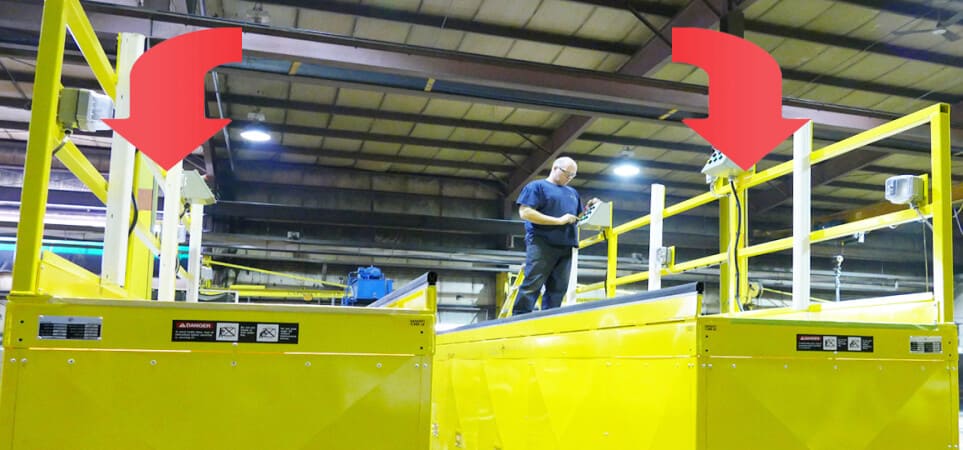
From guardrails, the following safety sub-category required to protect workers is personal fall systems. These are used in conjunction with guardrails to provide more fall protection, primarily when workers need to move away from the scissor lift platform. Personal fall protection systems are made up of:
- A body holding tool – an entire body and sitting harness, rescue harness, rescue loop and work positioning belt, rescue harness
- An attachment device – includes an anchor tool connected to a solid and stable anchorage point.
Fall protection legislation requires companies to use some or all of the measures below, depending on the project or industry:
- Fixed barriers such as handrails and guardrails
- Surface opening protection such as covers, guardrails, hazard signs
- Warning signs and control zones
- Fall or travel restraint protection systems to prevent operators from falling from an elevated position, or from moving to an unprotected edge from where the worker could fall)
- Fall containment devices such as safety nets made from sturdy materials
- Fall arrest systems to stop a worker’s fall before hitting a surface. These include rescue harnesses and work positioning belts.
Personal Protection Equipment (PPE) is any device, accessory, or equipment designed for wear during work operations to protect workers from hazards likely to injure or endanger their life. Scissor lift operations require specialized PPE to provide an additional layer of protection. In as much as a scissor lift has guard rails and fall arrest systems, workers need extra safety to protect them from hazardous materials, falling objects, and bodily harm. PPE for scissor lift operators include:
These include harnesses, lanyards, retractable, rescue loops, fall protection anchors, tool tethers, vertical and horizontal lifelines.
Equipment under this category includes masks and goggles designed according to safety specifications. Eye and face protection must meet the impact resistance criteria outlined by the Canadian Standards Association (CSA). Common hazards that covered my face and eye protectors are flying objects, molten material, chemical burns, abrasive materials, glare, and harmful optical radiation.
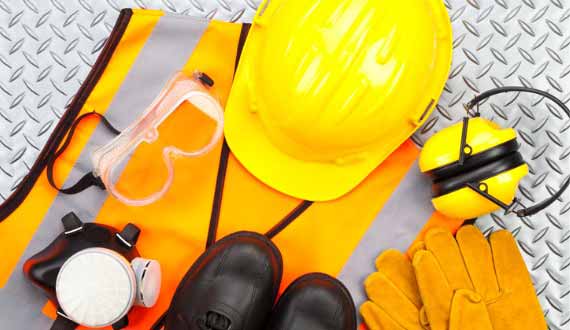
Foot protection covers work-related injuries from punctures, sprains, crushing, cuts, slips, and falls. Scissor lift operators need sturdy footwear that holds firmly on the surface since they’re operating on a limited surface area. Footwear specially designed for workplace protection must meet these CSA standards:
- Footwear must have a steel toe cap covering the whole length of the toes to beyond the natural bend of the foot. Comfort is a necessity, and all incorrect designs should be reported.
- Customize soles according to the hazards and floor types in the workplace.
- Customize non-slip footwear to every surface type to prevent injuries from using the wrong footwear on certain kinds of surfaces.
- All PPE footwear should have a steel midsole to protect the wearer’s foot from penetration by sharp objects while still being flexible enough to ease movement.
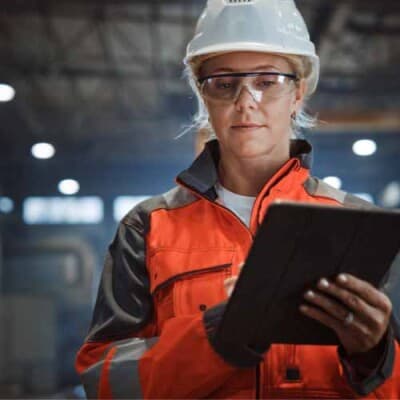
Scissor lift operators face potential hazards from falling objects and materials. The CSA Standard Z94.1-15 “Industrial protective headwear – Performance, selection, care, and use” stipulates the requirements for correct PPE headwear. Factors to consider in headwear protection equipment:
- Protective headwear is made of a shell and suspension that work together as a system. These parts require regular inspection, maintenance, and immediate replacement if they’re faulty.
- Do not store headwear in the rear window of vehicles during transportation to prevent heat and UV damage from sunlight. This damage reduces headwear quality and makes them protective.
- Inspect headwear and all its moving parts before the first and repeated use.
- Always confirm with the manufacturer when adding your own accessories like stickers, tape, masks, welder’s cap, etc.
- Ensure winter liners do not interfere with the fit of headwear.
- The wearer should not draw the chin strap over the peak of the headwear.
- Do not wear non-PPE hats under the protective headwear as not to interfere with suspension.
- Users should only wear the protective hard hat with the peak at the back if the suspension is adjusted. This way, the strap stays at the back of the head without unnecessary movements during work operations. Always check with the manufactures to confirm how the hard hat should be worn.
- If high visibility headwear is needed for work operations, confirm with CSA Standard Z96 High-visibility safety apparel for color and reflective performance specifications.
- Chemicals can degrade the headwear material affecting its overall effectiveness. Consult with your manufacturer on what chemicals are compatible with the PPE.
Workers operating scissor lifts need to wear hearing protection due to loud machinery and electric noises that can cause noise-induced hearing loss (NIHL). The occupational noise exposure limit is 85 decibels, so anything above that will cause damage. Criteria for selecting the right noise protection equipment includes:
- Equipment correct for the work. The Canadian Standards Association (CSA) Standard Z94.2-14 (R2019) outlines the proper standards to follow while manufacturing or acquiring noise protection devices.
- It should be compatible with external communication devices or other PPE that have to be worn.
- Comfortable to the wearer regardless of head size.
- They are designed according to the humidity of the workplace.
- It does not distract the wearer from hearing alarms, notification sounds, warning sounds, or machinery noises.
- Equipment that provides adequate noise protection for your specific industry. Manufactures design noise protecting devices for particular sectors and provide instructions on attuning the equipment for maximum protection.
The factors determining hazardous PPE effectiveness are their permeation rates and degradation. Permeation is the rate at which the chemical moves through the material to contact the skin, and degradation measures the level of physical degradation to the material. Hazardous PPE is also an essential addition to scissor lift safety to protect workers from chemical leakages while working on elevated surfaces in industries that handle hazardous materials.
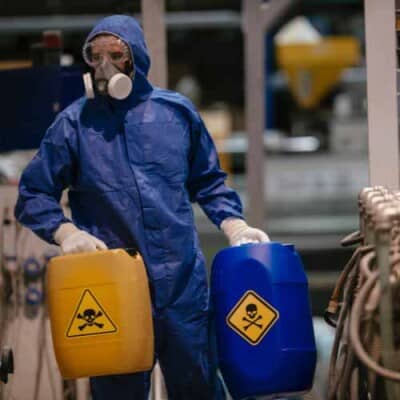
The EU directive overseeing personal protective equipment excludes the following items from the PPE category:
- Ordinary working uniforms and clothing that does not protect workers from safety and health hazards
- Equipment used by rescue and emergency services does not qualify as PPE
- Clothing or uniform is worn or used by the police, military, the police, and other public order institutions;
- Road transport PPE
- Sporting equipment;
- Self-defense equipment;
- Portable equipment for detecting and signaling risks
In Canada, employers are required to provide and maintain the PPE in good order, and workers are required to use PPE during relevant job operations. Workers are also prohibited from removing PPE and should report to their employer or supervisor in case of defective PPE.
Secondary fall protection systems are backup safety measures used to catch workers if they’ve already fallen off from a scissor lift. Secondary scissor lift fall protection options should only be used if the primary fall protection fails or when the immediate protection cannot be used due to structural or technical reasons.
The two fall options should be independent of each other so that if the primary level fails, the secondary option should work without any hindrance.
Secondary scissor lift fall protection systems include guardrails, protection covers, safety nets, and any other barrier restraining an operator’s travel to the fall hazard.
The scissor lifts safety has dramatically improved over the years thanks to technology and innovation. A company looking to purchase scissor lifts for their projects must factor in all the aspects documented above to prevent deaths, injuries, and costly legal challenges.
Handling Specialty builds custom scissor lifts to strict standards that consider a client’s business application, the protection of operators, and applicable occupational health and safety regulations.
Our design capabilities, engineering expertise, and time-tested reputation have established us as leaders in building made-to-order material handling equipment for all types of industries. Contact us today for more information.




